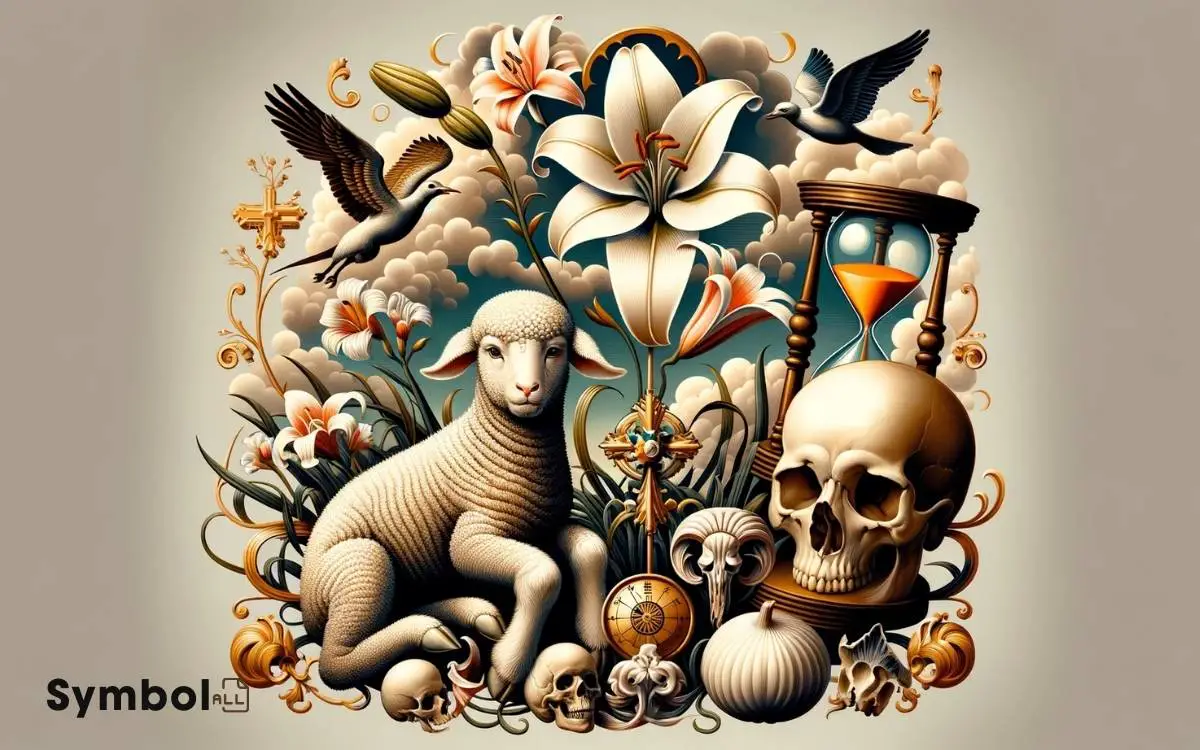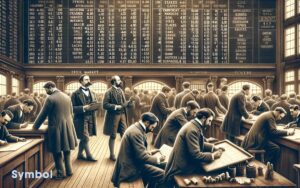What Were the Most Commonly Used Symbols in Flemish Art?
In Flemish art, you’ll often encounter symbols rich in depth and meaning. The enigmatic apple and humble snail depict life’s transient nature and the virtue of patience, respectively.
You’ll marvel at the diligent bee and opulent peacock, emblematic of societal industriousness and divine omniscience.
Loyalty and faith are illustrated through the faithful dog and sacred lamb, while the solemn skull and pure lily poignantly remind you of life’s ephemeral quality.
Each symbol, from the fertile pomegranate to victory’s triumph, weaves a complex narrative about morality, faith, and the human condition. Exploring further unveils even deeper layers of interpretation.

Key Takeaways
The Enigmatic Apple
In Flemish art, the apple often serves as a multifaceted symbol, embodying themes of temptation, knowledge, and the transient nature of life. When you delve deeper, you’ll find that its representation extends beyond the biblical narrative of Adam and Eve.
Artists employed the apple to signify a range of human experiences and moral lessons, embedding these elements within the visual context of their works.
For instance, the apple’s presence might subtly comment on the pursuit of forbidden knowledge or the inevitable decay that all flesh is heir to.
Through meticulous composition and symbolism, Flemish painters communicated complex ideas, inviting viewers to reflect on the apple’s layered meanings.
This nuanced approach underscores the apple’s significance not just as a fruit, but as a potent symbol within the rich tapestry of Flemish art.
The Humble Snail
At first glance, the humble snail in Flemish art may appear as mere background detail, yet its presence embodies a profound commentary on themes of patience, resilience, and the natural order.
You’ll find that artists meticulously incorporated this creature into their works, not for mere decoration, but to imbue their canvases with layers of meaning. The snail, with its slow pace, symbolizes not just patience, but also the inevitability of progress, no matter the speed.
Its hard shell suggests resilience in the face of adversity. By including the snail, artists remind viewers of the importance of grounding in the natural world, highlighting a harmonious balance between human ambition and the earth’s enduring, measured rhythm.
This symbol serves as a testament to the depth and thoughtfulness of Flemish artistry.
The Diligent Bee
You’ll find that the diligent bee, a recurring motif in Flemish art, encapsulates more than mere industry and teamwork. Its symbolism, deeply embedded within the artworks, often mirrors societal values and religious beliefs prevalent during the period.
Bee Symbolism Explained
Exploring the symbolism of bees in Flemish art reveals their representation as emblems of diligence and industriousness, reflecting societal values deeply ingrained in the culture of the time.
These tiny creatures, often overlooked, held profound significance within the artistic lexicon, embodying virtues of hard work and community that were highly esteemed.
| Symbol | Meaning |
|---|---|
| Bee | Diligence and industriousness; a metaphor for hardworking individuals and communities. |
| Hive | Society; symbolizing the interconnectedness and the collective effort required for its prosperity. |
| Honey | Reward; representing the sweet outcomes of perseverance and dedication to one’s duties. |
In dissecting bee symbolism, you discover a layered narrative that speaks volumes about the values and aspirations of the Flemish people, encouraging a deeper appreciation for these artworks. In dissecting bee symbolism, you discover a layered narrative that speaks volumes about the values and aspirations of the Flemish people, encouraging a deeper appreciation for these artworks. The industrious and collective nature of bees often mirrors human ideals of hard work, cooperation, and the pursuit of a shared goal. Through such imagery, we gain insight into the symbols people use to communicate intricate cultural identities and shared moral virtues that transcend time and language. This allegorical depth enriches the viewer’s understanding of the intricate connections between art, nature, and societal values.
Artistic Representations in Flemish
Delving into Flemish art, one observes how the diligent bee emerges as a recurring motif, symbolizing the virtues of hard work and communal effort.
This representation isn’t accidental. Flemish artists meticulously integrated the bee into their works, often in the background or subtly positioned to complement the central theme, thereby enriching the narrative depth.
You’ll find the bee depicted amidst florals in still life paintings, signifying nature’s bounty and the industriousness required to cultivate it. In religious and allegorical scenes, the bee embodies the ideal of tireless devotion and collective welfare.
Through detailed observation, it becomes evident that these artists weren’t just painting an insect; they were encoding a complex web of societal values and ethical principles, urging viewers to look beyond the surface for deeper meanings.
The Faithful Dog
You’ll notice that the faithful dog often emerges as a potent symbol of loyalty in Flemish art, serving not just as a background detail but as a key to understanding the depicted individual’s character.
When dogs appear in portraits, they’re not mere pets; they embody the sitter’s virtues, highlighting a bond that transcends the mere aesthetic.
This depiction extends to their role as protective companions, suggesting a deeper narrative of trust and guardianship within the artwork.
Symbolism of Loyalty
In Flemish art, the depiction of a faithful dog often serves as a potent symbol of loyalty, embodying the unwavering bond between humans and their companions.
This emblematic use of dogs goes beyond mere representation; it’s steeped in layers of meaning that resonate with themes of fidelity, protection, and trust.
When you delve into the symbolism, you’ll find:
- Fidelity: Dogs are portrayed as steadfast companions, suggesting an ideal of unbreakable loyalty.
- Protection: Their presence implies a protective stance, guarding not just the physical but the moral integrity of their owners.
- Trust: The unwavering gaze of a dog towards its owner symbolizes trust, a crucial element in the human-animal bond.
- Guidance: Dogs sometimes represent spiritual or moral guidance, leading their owners towards virtue.
This rich symbolism invites you to appreciate the multifaceted roles dogs play in art and life, beyond their physical presence.
Dogs in Portraits
Many portraits from the Flemish tradition notably include dogs, symbolizing the faithful companionship and unwavering loyalty these animals provide to their human counterparts.
This inclusion isn’t merely decorative but deeply symbolic, reflecting societal values and personal virtues.
The dog, often positioned at the feet of the subject or gazing up at their master, serves as a visual metaphor for fidelity and trustworthiness. The breed, size, and positioning of the dog within the portrait can further elucidate the intended message or status of the individual depicted.
For instance, hunting dogs alongside nobility underscore the subject’s aristocratic status and virtues such as courage and perseverance.
Hence, the presence of dogs in Flemish portraits transcends mere representation, offering insights into the cultural and personal symbolism of the era.
Protective Companions Depicted
Delving deeper into the role of dogs in Flemish art reveals their portrayal not only as symbols of loyalty but also as vigilant protectors, embodying the dual qualities of companionship and guardianship.
This multifaceted representation underscores the rich symbolism dogs held in this period.
Here’s an analytical breakdown:
- Guardianship: Dogs are often positioned near doorways or at their owner’s feet, signaling their role in protecting the physical and symbolic thresholds.
- Loyalty: Through direct eye contact with the viewer or a close proximity to their master, dogs emphasize unwavering fidelity.
- Moral Vigilance: Their presence in scenes of domesticity or leisure subtly reminds viewers of the moral and spiritual vigilance required in daily life.
- Symbolic Presence: Dogs symbolize faithfulness and trustworthiness, virtues highly prized in Flemish society.
The Sacred Lamb
Central to the iconography of Flemish art, the Sacred Lamb symbolizes innocence and sacrifice with profound theological implications. You’ll find that this motif isn’t just a passive figure; it’s imbued with layers of meaning, echoing the Christian narrative of redemption and purity.
The lamb often appears with a halo or bearing a flag, signifying victory over death, underscoring its messianic representation.
| Aspect | Symbolism | Context in Flemish Art |
|---|---|---|
| Halo | Divinity | Indicates sacredness |
| Flag | Victory | Christ’s triumph over death |
| White Color | Purity & Innocence | Emphasizes sinlessness |
| Bound Legs | Sacrifice | Foreshadows crucifixion |
| Presence | Divine Approval | Sanctifies the scene |
Through this lens, the Sacred Lamb doesn’t just represent; it communicates a rich tapestry of theological doctrine, serving as a pivotal emblem within the broader narrative Flemish artists sought to convey.
The Opulent Peacock
Shifting our focus from the Sacred Lamb, we now explore the Opulent Peacock, a symbol rich in both visual splendor and layered meanings within Flemish art.
This majestic bird wasn’t just chosen for its aesthetic appeal; it carried profound symbolism:
- Immortality: The peacock’s ability to shed and regrow its feathers symbolized renewal and the eternal life of the soul.
- Vigilance: With eyes on its tail feathers, it represented all-seeing knowledge and the omniscience of the divine.
- Royalty: Its regal appearance and demeanor made it a symbol of nobility and grace.
- Resurrection: The peacock was often associated with the resurrection of Christ, reinforcing themes of death and rebirth.
In Flemish art, the peacock wasn’t just a bird but a multifaceted symbol woven with intricate theological and royal connotations.
The Solemn Skull
In Flemish art, the solemn skull serves as a powerful emblem of mortality, inviting viewers to contemplate the transient nature of human life.
This symbol, prevalent across various works, isn’t merely a reminder of death but a prompt to reflect on the ephemeral nature of earthly achievements and pleasures.
| Symbol | Meaning |
|---|---|
| Solemn Skull | The inevitability of death and the transient nature of life. |
| Cracked Crown | The futility of power and wealth in the face of mortality. |
| Candle | Life’s fragility, with the flame representing the soul. |
| Hourglass | The swift passage of time leading to inevitable death. |
| Wilted Flowers | The fleeting beauty and vitality of life. |
Each element intricately woven into the fabric of Flemish artwork encourages a deeper, more reflective engagement with the viewer, urging them to ponder life’s ultimate truths.
The Fertile Pomegranate
The fertile pomegranate, symbolizing abundance and fertility, emerges as a nuanced emblem within Flemish art, inviting you to delve into the layers of meaning behind its depiction.
This symbol’s significance is manifold:
- Representation of Life and Death: The pomegranate’s seeds encapsulate the cycle of life, illustrating both the potential for new life and the inevitability of death.
- Symbol of Marriage and Fertility: Often featured in wedding portraits, it underscores the hopes for a fruitful union.
- Religious Connotations: It’s linked to the Resurrection and the promise of eternal life, reflecting deep spiritual beliefs.
- Artistic Metaphor: For artists, it served as a metaphor for their craft—each seed representing the potential of their creativity to bear fruit.
Understanding the pomegranate’s symbolism offers insights into the broader cultural and spiritual landscapes of Flemish society.
The Pure Lily
Delving into the symbolism of the pure lily, you’ll uncover its representation of purity and innocence, deeply embedded within the fabric of Flemish art. This symbol transcends mere decorative elements, embodying theological and philosophical ideals.
The lily’s association with the Virgin Mary highlights its significance in conveying notions of chastity and divine love.
| Symbol | Meaning | Context in Art |
|---|---|---|
| Pure Lily | Purity & Innocence | Often accompanies depictions of the Virgin Mary |
| Divine Love | Symbolizes divine favor and purity of heart | |
| Chastity | Used in scenes emphasizing chastity and virtue | |
| Renewal | Represents rebirth and purity of the soul | |
| Transcendence | Elevates scenes to a spiritual plane |
The lily’s presence in Flemish art serves as a multifaceted symbol that enriches the narrative, inviting viewers to contemplate deeper spiritual truths.
Conclusion
In Flemish art, you’ve journeyed through a realm where apples whisper of knowledge, snails pace the march of time, and bees buzz diligence into the air.
You’ve seen dogs embody loyalty, lambs carry sanctity, while peacocks flaunt opulence amidst solemn skulls that contemplate mortality.
The pomegranate seeds burst with fertility, lilies purify with their presence. Each symbol, meticulously chosen, weaves a rich tapestry of meaning, inviting you into a deeper understanding of the human condition and the natural world.





